Browse Primary Sources
Locate primary sources, including images, objects, media, and texts. Annotations by scholars contextualize sources.
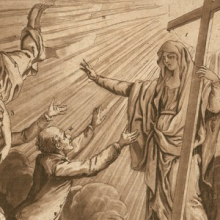
Through Me You Are All Brothers
Reflecting the sentiments of the French Revolution, this image shows the three orders unified by religion. The Virgin standing at right in a cloud holds a cross from which rays emanate to three figures representing the clergy, nobility, and Third Estate.
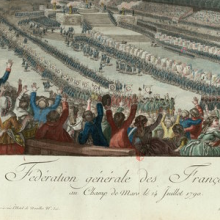
General Federation of the French
This image provides a visual overview of the Festival of Federation of 14 July 1790. Commemorating the fall of the Bastille one year earlier this massive military parade of troops from all regions of the kingdom converged on a triple–tiered triumphal arch where all the soldiers swore an oath to serve the king and the National Assembly.
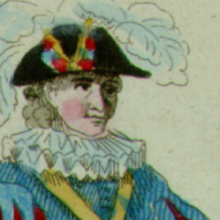
The Joyous Accord
This allegorical image represents the sentiments of social unity that the National Assembly sought to promote through the Festival of the Federation of 14 July 1790 during the French Revolution. This festival, though technically but a military parade of units from around the country, also implied to most observers the unity of all orders and classes.
Tension between Rich and Poor
The Marquis de Mirabeau, a well–educated nobleman, worried about the migration of French nobles to the cities and the passing of lands into the hands of "new men," wealthy commoners without a sense of paternal obligation toward the peasants on that land.
Scandal at the Church: José de Alfaro Accuses Doña Theresa Bravo and Others of Insulting and Beating His Castiza Wife, Joséfa Cadena (Mexico, 1782)
Systems of honor in colonial Mexico meant that insults were more than just Swords. Utterances that defamed men and women of good reputation had to be answered or the slight to their personal status within the community would be permanent. Gossip underscored these taints, and although usually not as open, it could serve the same purpose as insults.
Beaumarchais’s Understandings of Inequality
Like his predecessors of earlier generations, playwright Pierre–Augustin Caron de Beaumarchais—who became an important figure of the late Enlightenment because of the controversy surrounding his work The Marriage of Figaro [1784]—believed that a truly rational society would not tolerate arbitrary inequality.
Montesquieu’s Attack on the Nobility
In his Persian Letters, published anonymously and abroad in 1721, Charles–Louis de Sécondat, Baron de Montesquieu, president of the Parlement of Bordeaux and a noble himself, made a scathing critique of nobility that set the tone for the philosophes’ attack on the inequality of eighteenth–century French society.
Voltaire’s Understanding of Inequality
This passage from François–Marie Arouet, pen–named Voltaire, who was perhaps the best–known writer of the eighteenth century, illustrates the spirit of investigation of the Enlightenment. The philosophes wanted to understand the rationale behind inequality, were particularly interested if there were natural reasons for it, or if inequality came wholly from social conventions.
A Bread Riot
Bread was the basic staple of most people’s diets, and variations in the price of bread were keenly felt by the poor, especially by women who most frequently bought bread in the marketplace.
Apprentices and Masters
Unlike the Marquis de Mirabeau, (see document Tension between Rich and Poor) Jacques Savary sought to promote commerce and those who engaged in it. In this excerpt from his 1757 edition of The Perfect Merchant, which was widely read, Savary comments on the proper relations between apprentices learning a trade and the masters who owned the shop.
The Saint–Marcel Neighborhood
The writer Louis–Sébastien Mercier recorded in his Portrait of Paris detailed and witty commentaries on many aspects of life among the common people. In this article on the Saint–Marcel neighborhood, he comments on the difficulties faced by urban workers.
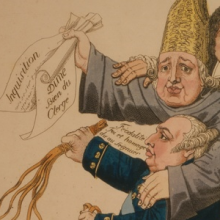
People under the Old Regime
This image shows "the people" as a chained and blindfolded man being crushed under the weight of the rich, including both clergy and nobility. Such a perspective on the period before 1789 purposely exaggerates social divisions and would have found few proponents before the French Revolution, but the image does reveal the social clash felt so intensely by the revolutionaries.
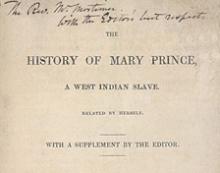
Excerpt from The History of Mary Prince
“The History of Mary Prince, A West Indian Slave Related by Herself” is first-person account was written by British abolitionists and disseminated through the London Society for the Abolition of Slavery in 1831. The source covers the three distinct areas of work: plantation work; housework; and work for other enslaved people.
The Traditional Order Defended
This newspaper article considers the question of equality from the opposite point of view—arguing that without social distinctions making clear who should lead and who should follow, society cannot hold together.
Arthur Young Views the Countryside
Arthur Young, an Englishman, traveled across France on the eve of the Revolution recording his impressions of life there, particularly those aspects that seemed to him to compare unfavorably with his native land.
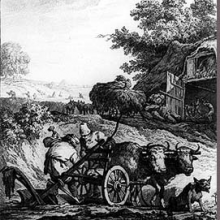
Two Peasants Repairing a Cart
This image of peasants repairing a cart demonstrates both the hard work done by cultivators and their fragile economic situation, which could easily be imperiled by a broken cart. Under such circumstances, poor people constantly repaired durable and personal goods, such as carts or clothing, because they could not afford to replace them with new ones.
Poverty in Auvergne
The difficulty of life in rural regions led some to leave home and seek a better life elsewhere, particularly in the growing cities. Such migration worried some observers, who feared villages would be emptied and no one would be left to work the land. In the excerpt below, a local government official in the Auvergne region comments on the causes and effects of emigration.
Poverty Observed!: Journal of a Country Priest
Village priests served as community leaders in a variety of respects, including keeping a register of births, marriages, and deaths. One such curate, the abbé Lefeuvre, also included in his register impressions of life during the severe winter of 1709, which give a sense of the difficult and fragile lives of the poor in rural towns in the eighteenth century.